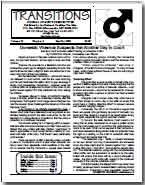
SBS Television’s Insight program is putting together a show on sexual harassment in the workplace. So far they’ve heard from a lot of women about their thoughts on sexual harassment; what do men think? Where do you draw the line? Have you ever experienced it? Or been accused of it yourself? They are keen to hear your stories or your thoughts on the topic. Please email kylet@sbs.com.au.
We thought it might be a good time to revisit an article from The Age published in November 2004 about men and sexual harassment.
The other end of the stick
The Age, November 16, 2004
Since sexual harassment became a hot issue in the 1970s it has generally been assumed that men are the perpetrators. But new research is turning this idea on its head. John Mangan reports.
Steve was an employee at a prominent Australian furniture retail organisation. He became romantically involved with a work colleague, Stacey, and was bitterly upset when their relationship ended. Within two months of their acrimonious split he attended the company Christmas party, where Stacey was being overtly romantic with another male colleague. The next working day Steve made a complaint to human resources, saying that he felt sexually harassed.
Ben, who was working at a Melbourne call centre, was in a gay relationship with someone outside his company when he was propositioned by a male supervisor who asked if they would be interested in a threesome. Ben rejected the advance and subsequently felt he was the subject of victimisation and intense scrutiny of his work performance by that manager as a result of his refusal.
He made a complaint to the Victorian Civil and Administrative Tribunal and the matter was resolved with the payment of about $5000 to Ben.
Last month a gay waiter won $9000 in compensation after VCAT found his former boss guilty of sexual harassment, telling friends and workers at his workplace that he was gay and encouraging them to make offensive remarks.
Since sexual harassment became a hot issue in the 1970s and ’80s, the assumption has been that men are the perpetrators, women the victims. Now, a rash of research is challenging that first principle, revealing that far more sexual harassment of men is going on than anybody guessed.
At this year’s 39th Australian Psychological Society Conference in Sydney, a University of New England study found that the men it surveyed had experienced more low-level sexual harassment than the women.
Also, a recent Deakin University survey found no gender differences in the experience of sexual harassment – in other words, men experienced it as much as women.
Overseas, a University of Minnesota study published in the American Sociological Review in April found that one in every seven men that took part in the survey reported they were sexually harassed by their mid-20s. Yet they had never told anyone about their experience prior to the study.
Men are supposed to be able to laugh it off if the harassment comes from a woman, be man enough to cop it sweet if it comes from another man.
“We were completely shocked when we analysed the data,” says Don Hine, a senior lecturer in psychology at the University of New England. His colleague Louise Fitzgerald was examining workplace stability and they noticed that the categories allowed them to do a male-female breakdown on sexual harassment.
Instead of looking at sexual harassment in general, they were able to break it down into three groups: gender harassment, unwanted sexual attention and sexual coercion.
“This kind of study has been done before and almost always finds that females have been more likely to be sexually harassed in the workplace,” says Hine. “So we were surprised when for the two milder forms of harassment, gender harassment and unwanted sexual attention, the males actually scored higher than the females.”
Marita McCabe, a professor of clinical psychology at Deakin, was similarly surprised by her research, which is set to be published in the Journal of Social Psychology next year.
“For each of the different types of harassment we looked at – touching, patting, fondling, staring and leering, right down to sexual assault – we found no differences between the responses for men and women. The message here is that workplaces need to take sexual harassment more seriously.”
The battle against sexual harassment of females has been fought over the past two decades with Sex Discrimination Commissioner Pru Goward reporting that Australians no longer regard the pursuit of sexual harassment as political correctness gone mad. Human Rights and Equal Opportunity Commission figures show that in cases where people witness such harassment, 87 per cent of witnesses will take some form of action, from comforting the victim to confronting the harasser.
A stigma, though, remains around sexual harassment of men. Men are supposed to be able to laugh it off if the harassment comes from a woman, be man enough to cop it sweet if it comes from another man.
Eyebrows were raised in the South Australian Parliament in September when Premier Mike Rann reprimanded MP Vini Ciccarello for her habit of pinching men’s bottoms. She admitted to having pinched the bottoms of the former governor Sir Eric Neal, former Liberal premier John Olsen, former Catholic Archbishop Leonard Faulkner and former prime minister Gough Whitlam.
Groping Gough sounds comic, but as Liberal MP Isobel Redmond told Parliament: “Had it been a male member of the Parliament, he would have been pilloried for that sort of behaviour and, in all probability, thrown out of the house.”
While football players have notoriously been the perpetrators of sexual harassment, consulting psychologist John Cheetham says they too can be on the receiving end, with AFL players he knows of being hassled by women in nightclubs or even just made to feel uncomfortable by constant, direct sexual comments at social events.
“It’s still not something that comes to light often because there’s still that stereotypical view that males are strong and superior, so they couldn’t be victims. Of course that’s mythology, but we’re still dealing with the mythology.”
The recent case of the schoolboy who had a sexual relationship with PE teacher Karen Louise Ellis is a good example of that male bravado. “It’s certainly perceived by society that he was the victim of predatory behaviour, but it seems that he would argue the opposite,” Cheetham says.
Don Hine emphasises that his University of New England sample was too small to be technically random, while Pru Goward points out that more comprehensive HREOC figures show sexual harassment of females remains a far greater problem.
A HREOC telephone survey found that only 28 per cent of those who reported being targets of sexual harassment were male. Interestingly, while substantially lower than the figure for females, it did suggest that males were far less likely to report problems, as men filed only 5 per cent of official complaints registered by the commission.
The fact remains that sexual harassment of men is coming out into the open, says Joydeep Hor, a partner at Harmers Workplace Lawyers.
“The incidence of males making complaints is definitely escalating,” he says. “We were doing a lot of workplace training at the time Ally McBeal was on TV and people were asking if those situations could really happen. I made the point that the plots were often based on actual cases in the US and, yes, one day it could happen here!”
Hor attributes the increase in sexual harassment complaints from men to a greater awareness of employee rights and the fact that the more eccentric cases get publicity. “The workplace is constantly changing. Private and personal lives are being brought more into the workplace in what I call the informalisation of the workplace, which is setting up a social context at work that is making these behaviours more likely.
“I think you can trace it back a couple of years to when firms decided to focus on casual clothes. Employers want to make employees feel more comfortable and relaxed with a view to them working harder and working longer. The reality is there are a lot more social activities connected with workplaces now, and social networks tend to be influenced much more by co-workers than 20 or 30 years ago.”
Hor says the kind of complaints he’s seeing now usually involve disputes with colleagues rather than with bosses. The University of New England and Deakin figures don’t indicate what proportion of male sexual harassment reported is being perpetrated by females or other males, but Hor estimates 70 per cent of the cases he sees are males against males.
“A lot of sociological issues come into it. There’s the stigma of males bringing claims against females, and the assumptions of what men should be able to put up with and even enjoy. That certainly is responsible for a lot of cases not being reported through formal channels.
“When I’m conducting training sessions and hearing males in the room talking about things that happen to them in their work environment, it’s very clear that those norms and perceptions are strong in their minds.”
The complaints registered with the HREOC tend to focus on co-worker harassment as well, Pru Goward says. “They’re often associated with initiation procedures for the new boy on the block. The older men might act out homosexual acts in front of him. In a big supermarket chain a few years ago there was a case involving women pulling their skirts up in front of the new blokes. Again, it was a case involving co-workers, not female supervisors.”
In the past three years of Goward’s commissionership the number of complaints registered from men has increased, but until men overcome the traditional mentality that they should be able to laugh off sexual innuendo or advances from either women or other men, Marita McCabe believes harassment will continue to be under-reported. “There’s such a cultural taboo against males reporting sexual harassment. Women are less likely to tolerate it whereas for men there’s this ‘just get over it’ mentality,” she says.
“It’s important to educate people to see sexual harassment as being damaging. Women in the past have experienced it so they know, but guys haven’t. I think often men don’t really understand the harm that’s done by it.”
■ Names have been changed in the examples used in this story.


